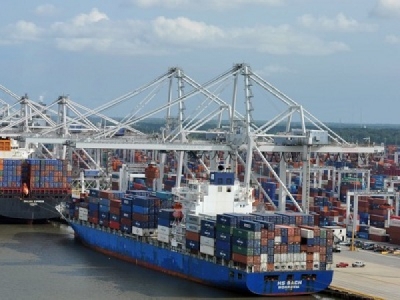
Posted on February 8, 2018
By J. Scott Trubey, myAJC
The state agency that runs the bustling ports in Savannah and Brunswick, seeing continued growth in ocean-bound cargo, is forming a master plan for a 10-year, $2.3 billion expansion of its capacity.
At a conference Monday in Sea Island, Georgia Ports Authority Executive Director Griff Lynch said investments the agency plans will allow the harbors to accommodate 10 million twenty-foot-equivalent units of cargo (TEUs), more than double the record of nearly 4 million TEUs the ports managed in fiscal 2017.
The Brunswick port, meanwhile, is working toward its goal of transporting 1.4 million vehicles per year, or more than double the 600,000 vehicles the auto port moves today.
“We’re investing heavily to do that and make that happen,” he said in an interview.
Georgia’s inland and coastal ports are vital cogs in the state’s economy. Georgia’s ports system accounts for some $40 billion in estimated economic impact across the state, and directly or indirectly touch about 400,000 jobs.
Lynch said the ports started a 10-year blueprint about six months ago using outside consultants and economists to judge future demand and potential steps to expand capacity.
Forecast models show traffic growing at the ports growing to 7 million TEUs by 2028. Lynch said the agency wants to plan for about 20 percent additional capacity to ensure smooth operations, which are affected by seasonality.
Port expansions would be paid for by operations not outlays by taxpayers, a ports spokesman said.
A number of expansion projects are underway or in the pipeline. The ports want to grow its fleet of ship-to-shore cranes to 42. The ports previously announced orders for 10 cranes, with plans to grow the fleet to 36 by 2020.
The ports authority expects to open this year the second inland terminal in northwest Georgia and start construction of a $128 million new mega rail project at the main Garden City Terminal.
Lynch said the ports forecast its Garden City Terminal could have the space, with some reconfiguration of the campus, to grow to 8 million TEU capacity. And expansion to 10 million TEUs could involve development off of its campus.
One possibility is the long-planned container ship terminal in Jasper County, S.C. The Jasper terminal, a joint effort by Georgia and South Carolina on the Savannah River, was originally announced in 2007 as a joint-venture between the states.
The long permitting process for the project started in 2016.
“We have to make sure that’s real and if we can deliver that by 2028,” Lynch said of the Jasper project. “If it’s not real, we have to look at other alternatives.”
Dredging to deepen the Savannah River channel to 47 feet from 42 feet continues. The mammoth project, now pegged at nearly $1 billion, is designed to allow larger freighters to pass to the Savannah port with greater flexibility.
The huge “post-Panamax” ships must now pass only at high tide and when less than fully loaded.
In December, the Army Corps of Engineers started work on the final segment of dredging of the Savannah River’s outer channel.
Lynch told the Georgia Foreign Trade Conference crowd the outer harbor dredging is expected to be finished in March, bringing the project to its halfway point. Full completion of the inner harbor is now expected in late 2021.
Lynch said the financial case for deepening the harbor continues to grow.
The ports’ reach is statewide. The metro Atlanta warehousing industry, for instance, including job growth and demand for space, is directly tied to the freight flowing into and out of state’s ports.
Metro Atlanta’s industrial real estate market — mainly warehouses — posted a record for “net absorption” or net space that was filled in 2017, totaling more than 21 million square feet, according to a report by real estate services firm CBRE. Vacancy rates declined to 7.3 percent.
The push for new warehouse space comes amid a post-recession rise in consumer spending and e-commerce demand. Much of the freight travels initially by ship and then by rail and truck.
Ports traffic has grown from 2.16 million TEUs in calendar year 2006 to 4.05 million TEUs last calendar year, according to CBRE.
Dan Wagner, regional research manager in Atlanta for CBRE, said absorption in warehouse space, particularly south of Atlanta, tracks growth in container traffic at Georgia’s ports.
“They are directly correlated,” he said.
Source: myAJC





